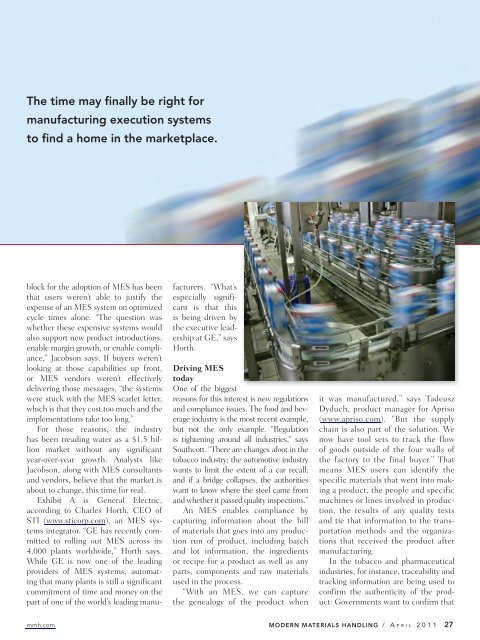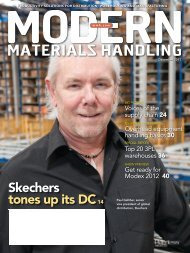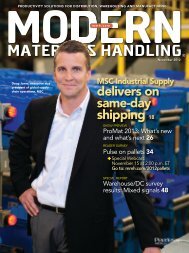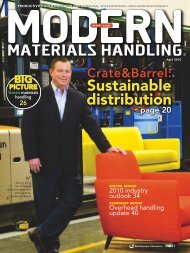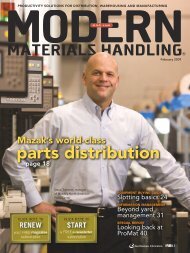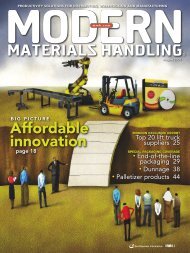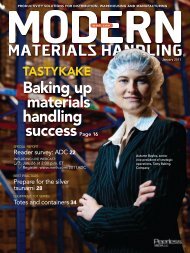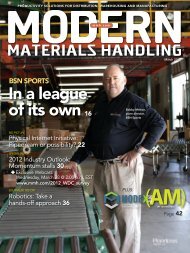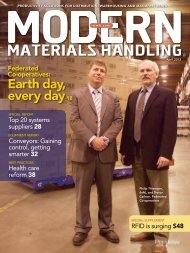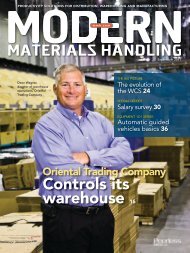Modern Materials Handling - April 2011
Modern Materials Handling - April 2011
Modern Materials Handling - April 2011
You also want an ePaper? Increase the reach of your titles
YUMPU automatically turns print PDFs into web optimized ePapers that Google loves.
The time may finally be right formanufacturing execution systemsto find a home in the marketplace.block for the adoption of MES has beenthat users weren’t able to justify theexpense of an MES system on optimizedcycle times alone. “The question waswhether these expensive systems wouldalso support new product introductions,enable margin growth, or enable compliance,”Jacobson says. If buyers weren’tlooking at those capabilities up front,or MES vendors weren’t effectivelydelivering those messages, “the systemswere stuck with the MES scarlet letter,which is that they cost too much and theimplementations take too long.”For those reasons, the industryhas been treading water as a $1.5 billionmarket without any significantyear-over-year growth. Analysts likeJacobson, along with MES consultantsand vendors, believe that the market isabout to change, this time for real.Exhibit A is General Electric,according to Charles Horth, CEO ofSTI (www.sticorp.com), an MES systemsintegrator. “GE has recently committedto rolling out MES across its4,000 plants worldwide,” Horth says.While GE is now one of the leadingproviders of MES systems, automatingthat many plants is still a significantcommitment of time and money on thepart of one of the world’s leading manufacturers.“What’sespecially significantis that thisis being driven bythe executive leadershipat GE,” saysHorth.Driving MEStodayOne of the biggestreasons for this interest is new regulationsand compliance issues. The food and beverageindustry is the most recent example,but not the only example. “Regulationis tightening around all industries,” saysSouthcott. “There are changes afoot in thetobacco industry; the automotive industrywants to limit the extent of a car recall;and if a bridge collapses, the authoritieswant to know where the steel came fromand whether it passed quality inspections.”An MES enables compliance bycapturing information about the billof materials that goes into any productionrun of product, including batchand lot information, the ingredientsor recipe for a product as well as anyparts, components and raw materialsused in the process.“With an MES, we can capturethe genealogy of the product whenit was manufactured,” says TadeuszDyduch, product manager for Apriso(www.apriso.com). “But the supplychain is also part of the solution. Wenow have tool sets to track the flowof goods outside of the four walls ofthe factory to the final buyer.” Thatmeans MES users can identify thespecific materials that went into makinga product, the people and specificmachines or lines involved in production,the results of any quality testsand tie that information to the transportationmethods and the organizationsthat received the product aftermanufacturing.In the tobacco and pharmaceuticalindustries, for instance, traceability andtracking information are being used toconfirm the authenticity of the product:Governments want to confirm thatmmh.com MODERN MATERIALS HANDLING / A P R I L 2 0 1 1 27


